Double Fertilization: Almost everyone knows about how fertilization / Pollination occurs in plants but Only angiosperms show double fertilization as a unique property. Because it uses both of the male gametes to fertilize the eggs, double fertilization is significant. By doing double fertilization, the likelihood of polyembryony is reduced and the likelihood that the future plant will survive is raised. The next section goes into detail about What is Double Fertilisation, the process, how the embryo develops after fertilization, significance, and more.
What is Double Fertilization?
All angiosperms have a distinctive technique known as double fertilization. Fertilization is the process by which a male gamete joins a female gamete to create a diploid zygote (2n). Double fertilization is the fusing of one male gamete with an egg and another male gamete with a secondary nucleus. There are two fusions involved, and two products are produced as a result. The life cycle is restored to diploidy by first fertilization. A new plant is created from a diploid zygote after it develops into an embryo. Triploid PEN (Primary Endosperm Nucleus), the second fertilization product, matures to generate endosperm, a nutritive tissue for the development of an embryo.
Double Fertilization Process
Before we go into the intricate procedure, let’s first look at double fertilization in its simplest form.
- Two sperm cells are used in double fertilization; one fertilizes the egg cell to create the zygote, while the other fuses with the two polar nuclei to create the endosperm.
- Following fertilization, the fertilized ovule develops into a seed, and the ovary’s tissues mature into a fruit.
- The zygote separates into two cells during the initial stage of embryonic development; one of these cells will become a suspensor, while the other will grow into a proembryo.
- Due to the existence of cotyledons, the growing embryo (in eudicots) has a heart-shaped form during the second stage of embryonic development.
- The seed is now ready for dispersal because the growing embryo is starting to twist as it covers the seed.
Double Fertilization Diagram
The double Fertilization diagram is given below. check it out.
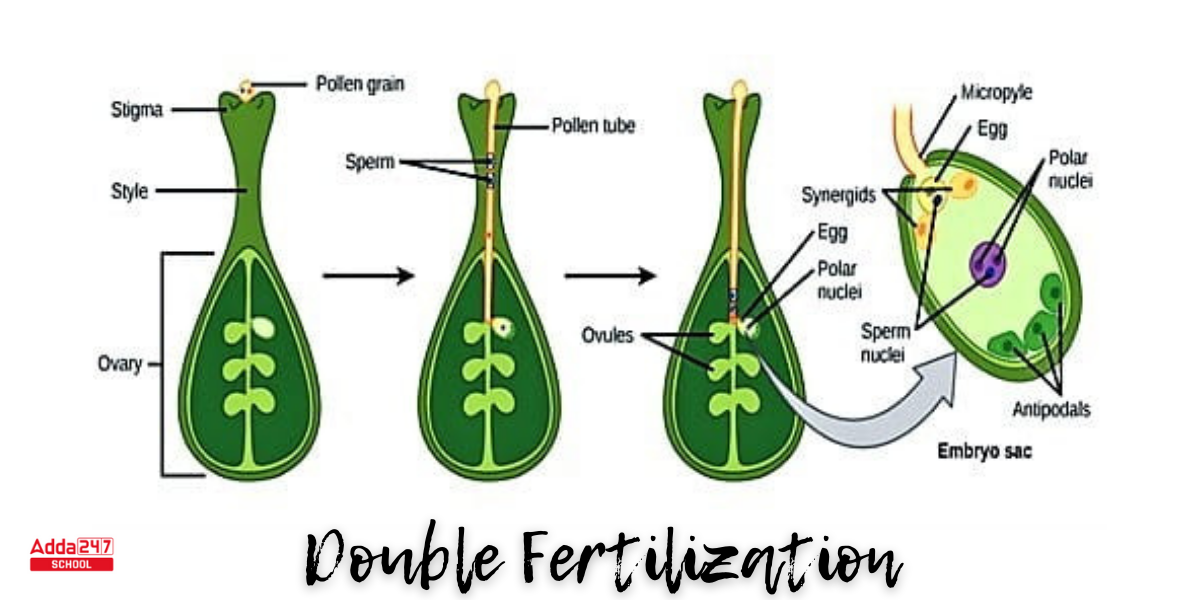
Double Fertilization Process in Angiosperm
The most diverse groups of naturally occurring plant life are angiosperms, which are flower-bearing plants. Angiosperms have distinct male and female reproductive organs in their reproductive system. Each contains gametes, namely sperm and egg cells. The Double Fertilization process in Angiosperm is discussed in detail in below step by step process below.
- Adherence to Pollen Gains on Stigma –
Pollen must germinate and develop through the style to reach the ovule after being deposited on the stigma (the male component). The pollen tube cell and the generative cell are the two cells that make up the microspores, or pollen.
- Formation of Pollen Tube –
The generative cell passes through the pollen tube cell as it develops into a pollen tube. Water, oxygen, and specific chemical signals are needed for the pollen tube to germinate. The tissues of the style assist the growth of the pollen tube as it passes through the style to reach the embryo sac.
- Entrance of Pollen tube into the ovule sac –
If the generative cell hasn’t already divided into two cells throughout this procedure, it does so immediately to create two sperm cells. The pollen tube enters the ovule sac through the micropyle, guided by the chemicals generated by the synergids found in the embryo sac.
- Fertilization through two Sperm Cells –
One of the two sperm cells fertilizes the egg cell to create a diploid zygote, while the other sperm cell fuses with both polar nuclei to create a triploid cell that becomes the endosperm. Double fertilization is the collective term used to describe these two fertilization processes in angiosperms.
Note – No additional sperm may enter after fertilization is finished. The tissues of the ovary develop into the fruit, which often encases the seed, while the fertilized ovule creates the seed.
Development of Embryo in Humans
The development of the embryo starts after fertilization. The zygote divides to produce the – upper cell, also known as the terminal cell, and the lower cell, also known as the basal cell. The suspensor, which finally connects with the maternal tissue, is created by the basal cell’s division.
- A pathway from the mother plant to the developing embryo is provided by the suspensor. The terminal cell divides as well, producing a proembryo with a globular form.
- The developing embryo of dicots (which have a pair of leaves, or cotyledons, in the seed) resembles a heart because they have two rudimentary cotyledons.
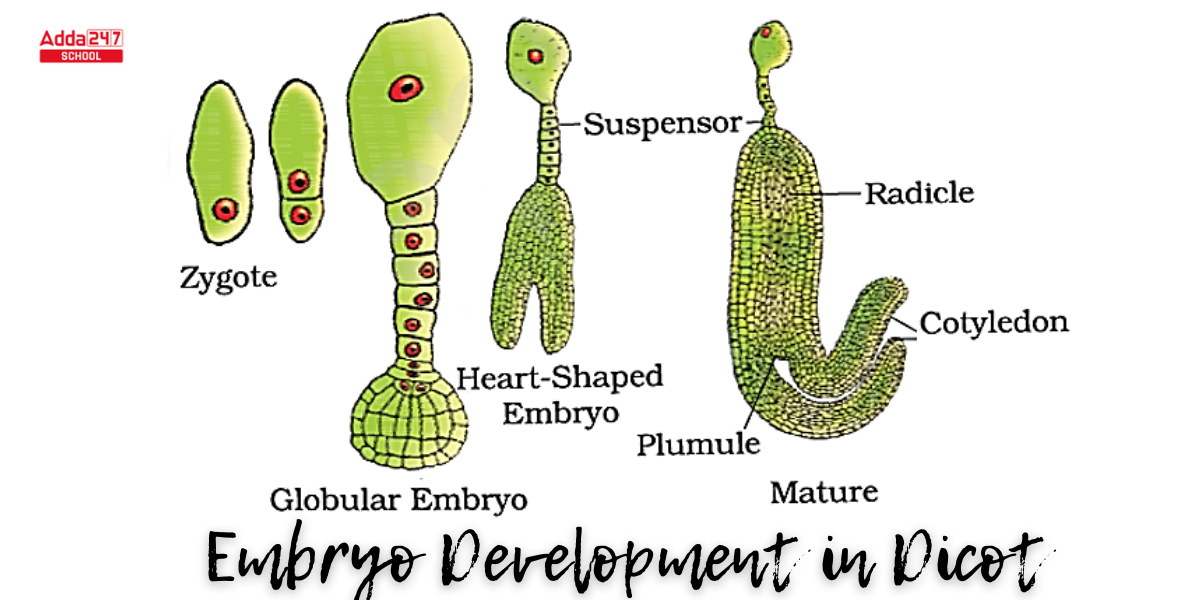
- Dicots that do not produce endosperm, like Capsella bursa, initially produce endosperm before it is digested. The food stores in this instance are transferred into the two cotyledons. As they grow, the cotyledons and embryos are crammed inside the growing seed and are compelled to bend. Eventually, the cotyledons and embryos fill the seed, at which point it is prepared for dissemination.
- After a while, embryonic development is halted; only when the seed germinates does growth resume. Till the first set of leaves starts photosynthesis, the growing seedling will depend on the food reserves kept in the cotyledons.
Importance of Double Fertilization in Plants
Only two fusions occur in Double fertilization, and only two products result from them. The following points are importance of double fertilisation in angiosperms.
- The two male gametes produced by a pollen grain are used in the double fertilization process.
- The triploid primary endosperm nucleus (PEN), which is the secondary byproduct of fertilization, develops into the endosperm and feeds the growing embryo.
- The result of the fusion process retains the diploid state throughout the life cycle. The diploid zygote develops into an embryo, which ultimately becomes a new plant.
- The re-fusion of traits caused by double fertilization results in a variance in the offspring.
- The seeds of angiosperms are quite accessible since angiosperms are known for their double fertilization.
दोहरा निषेचन क्या है
दोहरा निषेचन: लगभग हर कोई जानता है कि पौधों में निषेचन/परागण कैसे होता है लेकिन केवल आवृतबीजी पौधे ही दोहरे निषेचन को एक अद्वितीय गुण के रूप में दर्शाते हैं। क्योंकि यह अंडों को निषेचित करने के लिए दोनों नर युग्मकों का उपयोग करता है, इसलिए दोहरा निषेचन महत्वपूर्ण है। दोहरा निषेचन करने से, बहुभ्रूणता की संभावना कम हो जाती है और भविष्य के पौधे के जीवित रहने की संभावना बढ़ जाती है। अगला भाग दोहरा निषेचन क्या है, प्रक्रिया, निषेचन के बाद भ्रूण कैसे विकसित होता है, महत्व और बहुत कुछ के बारे में विस्तार से बताता है।
दोहरा निषेचन क्या है?
सभी आवृतबीजी पौधों में एक विशिष्ट तकनीक होती है जिसे दोहरा निषेचन कहा जाता है। निषेचन वह प्रक्रिया है जिसके द्वारा एक नर युग्मक एक मादा युग्मक से जुड़कर द्विगुणित युग्मनज (2n) बनाता है। दोहरा निषेचन एक नर युग्मक का अंडे के साथ और दूसरे नर युग्मक का द्वितीयक केन्द्रक के साथ संलयन है। इसमें दो फ़्यूज़न शामिल हैं, और परिणामस्वरूप दो उत्पाद तैयार होते हैं। पहले निषेचन से जीवन चक्र द्विगुणित हो जाता है। भ्रूण के रूप में विकसित होने के बाद द्विगुणित युग्मनज से एक नया पौधा बनता है। ट्रिपलोइड पीईएन (प्राथमिक एंडोस्पर्म न्यूक्लियस), दूसरा निषेचन उत्पाद, भ्रूण के विकास के लिए एक पोषक ऊतक, एंडोस्पर्म उत्पन्न करने के लिए परिपक्व होता है।
दोहरी निषेचन प्रक्रिया
इससे पहले कि हम जटिल प्रक्रिया में जाएं, आइए सबसे पहले दोहरे निषेचन को इसके सरलतम रूप में देखें।
दोहरे निषेचन में दो शुक्राणु कोशिकाओं का उपयोग किया जाता है; एक युग्मनज बनाने के लिए अंडे की कोशिका को निषेचित करता है, जबकि दूसरा दो ध्रुवीय नाभिकों के साथ जुड़कर भ्रूणपोष बनाता है।
निषेचन के बाद, निषेचित बीजांड एक बीज के रूप में विकसित होता है, और अंडाशय के ऊतक एक फल के रूप में परिपक्व होते हैं।
भ्रूण के विकास के प्रारंभिक चरण के दौरान युग्मनज दो कोशिकाओं में विभाजित हो जाता है; इनमें से एक कोशिका सस्पेंसर बन जाएगी, जबकि दूसरी विकसित होकर प्राक्भ्रूण बन जाएगी।
बीजपत्रों के अस्तित्व के कारण, भ्रूण के विकास के दूसरे चरण के दौरान बढ़ते भ्रूण (यूडिकोट्स में) का आकार हृदय के आकार का होता है।
बीज अब बिखरने के लिए तैयार है क्योंकि बढ़ता हुआ भ्रूण बीज को ढकने के साथ ही मुड़ना शुरू कर रहा है।

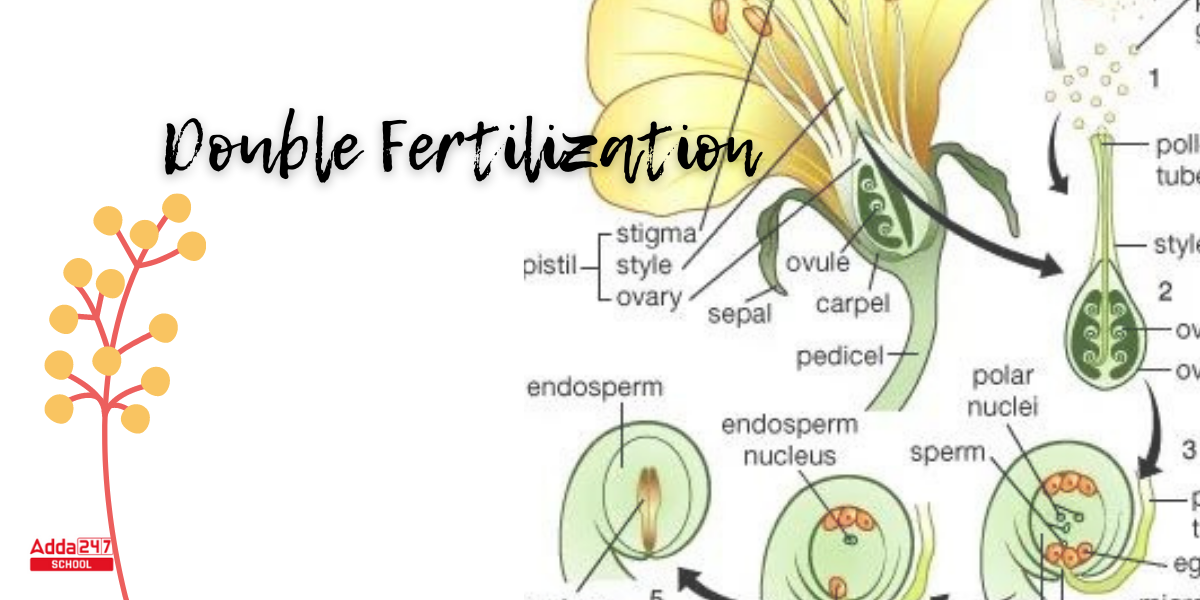







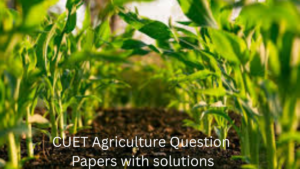 CUET Agriculture Previous Year Question ...
CUET Agriculture Previous Year Question ...
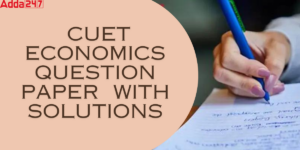 CUET Economics Previous Year Question Pa...
CUET Economics Previous Year Question Pa...
 CUET Maths Previous Year Question Paper,...
CUET Maths Previous Year Question Paper,...














